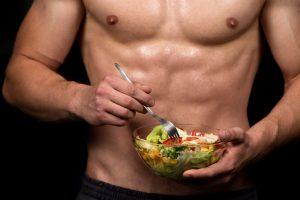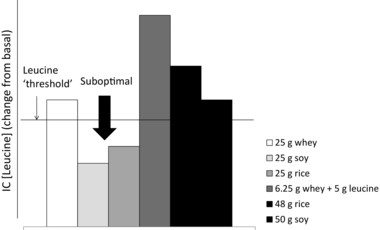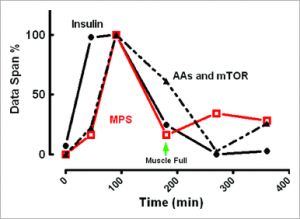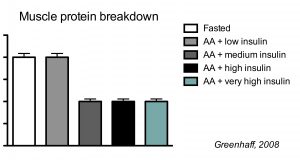So you have a good training programme, and understand that eating protein is the basis of how to eat to gain muscle. This works to a certain extent, but wouldn’t you rather maximise your gains? In a seminar with leading nutrition expert and figure competitor Martin MacDonald, I discovered some surprising facts. For one, simply eating more protein is NOT enough. In this article, I share his knowledge so you can make the most of your nutrition for muscle gain.

How to Eat to Gain Muscle: Important Points About Protein
Let’s start with the basics. MacDonald explains that it is biologically impossible to build muscle without protein. He highlights that the government’s RDA of 0.8g per kilo of bodyweight is actually just above the point of protein malnutrition. In his interview with Big Picture Education, he states using a minimum of 1.5g per kilogram of body weight as a daily protein recommendation for his clients.
However, MacDonald emphasises that total protein intake is NOT the most important factor when it comes to how to eat to gain muscle. To understand why this is, let’s look at two important concepts.
The Leucine Threshold
Leucine is a branch chain amino acid found in protein. This amino acid can independently stimulate muscle protein synthesis (MPS). MPS is directly linked to muscle growth. Therefore, leucine is perhaps the most crucial of the amino acids for muscle gain. Many protein-rich foods contain leucine, such as animal protein and whey. However, when it comes to how to eat to gain muscle, just consuming these foods might not be enough.
When you consume leucine, the body delegates it for many different processes. It only uses a small amount for MPS. So, to stimulate muscle building, you need to consume enough leucine in a single sitting to reach a ‘leucine threshold’. MacDonald advises a minimum of 2.3-2.5g per meal. He says that eating this amount leads to maximal MPS.
Protein Per Meal
Because protein consists of many other branch chain amino acids, it isn’t easy working out the exact amount of leucine in your protein sources. Some foods with high protein content actually have less leucine than you’d expect. Chicken, for example, has 31g of protein per 100g, 2.3g of this being leucine. However, cottage cheese has only 10g of protein per 100g, but a higher leucine content – 2.9g.

So, instead of whipping your calculator out every time you eat, MacDonald advises that you aim to consume a minimum of 0.4 to 0.5g per kilo of bodyweight in good quality protein per meal. This ensures you’ll get enough leucine. MacDonald says the exception here is whey shakes. Whey typically contains large amounts of leucine. It’s worth checking the content of your particular brand, but you generally only need 30-35g (equal to about one serving) to hit the leucine threshold. Therefore, consuming shakes between meals is a great ‘whey’ to eat to gain muscle (excuse the pun).
Pre-Sleep Protein
MacDonald also highlighted the importance of a larger bolus of protein before bed. This has proven to be an effective way to maintain MPS throughout the longest time we go without food. Recent research by Jorn Trommelen, who holds a Ph.D. in muscle protein synthesis, demonstrates this (Trommelen & Van Loon, 2016, Trommelen et. al, 2018). Trommelen explains that consuming pre-sleep protein acts as a bridge for the 12 or so hours between an evening meal and breakfast. Trommelen recommends a more substantial amount of protein than usual before bed due to the length of time until we next eat. His study shows that 30g has been sufficient for athletes, with the possibility that 40g could induce even better results (Trommelen, 2018).
So, from this, we could conclude that how to eat to gain muscle is simple – just consume large amounts of protein, all the time, right? In a word, no. This is where the theories of the muscle full effect and the refractory period come in.
The Muscle Full Effect
Given the above, we might assume that how to eat to gain muscle breaks down into just eating vast quantities of protein all throughout the day. We consistently hit our leucine threshold, and as long as we’re training alongside this, our muscles grow. I wish it was that simple! However, this is not the case. Many experts believe that there is a point at which protein synthesis stops, despite continuous feeding of protein. They call this the ‘muscle full effect’.
It’s important to understand this concept if you want to know how to eat to gain muscle. Every time you consume a meal with a large enough dose of protein to hit your leucine threshold, MPS is initiated. This peaks at around 2 hours after ingesting protein, and then returns to baseline. This has been observed to happen even if you continue to consume further protein after the meal. Therefore, it is theorised that the body must use up the amino acids it already has, before being able to take on any more. This is termed the ‘muscle full effect’.
The Amino Acid Drip Study
MacDonald described a study by Bohé et al. (2001) which tested this. Participants were intravenously fed amino acids while MPS was measured. This study observed a peak in MPS at around 2 hours after the feeding began. After this though, despite the continuous supply of amino acids, this rapidly dropped back to baseline. They observed the ‘muscle full effect’ at work, and could not re-stimulate protein synthesis after the body had sent a signal that the muscles were ‘full’.

From this study, we can deduce that after a high enough dose of protein, MPS peaks and then drops. This happens despite continuous feeding of protein. Figure 1 shows this. Despite amino acids being available (the black dashed line), MPS drops after 90 minutes or so. According to the muscle full effect theory, after the body gets enough protein for MPS, it signals that the muscles are ‘fed,’ and thus protein synthesis stops. Therefore, it seems from current research that there is a period in which MPS cannot be stimulated again, despite whether or not more protein is consumed. This is termed the refractory period.
The Refractory Period
There is some debate on how long the refractory period exactly is, but MacDonald refers to a general consensus of somewhere between 4-5 hours. In terms of how to eat to gain muscle, this theory states that there’s little point in continuously consuming protein within this refractory period.
Some even suggest that keeping your amino acid levels topped up with small protein doses through the day could actually inhibit the spikes in MPS we want. Layne Norton, Ph.D., for example, explains this. “It may be that a period where amino acids return to baseline or near baseline is required to initiate another bout of protein synthesis” he states in his article for Simply Shredded. Because of this, both Norton and MacDonald advises consuming larger quantities of protein in one sitting and spread these over 4-5 hours.
Given this, we could simply wait 4-5 hours between eating, and get high amounts of protein at each interval. However, waiting this long to eat could leave us without enough calories through the day to support muscle growth. Going by the theory of the refractory period, further consumption of protein will have little effect during this time. Plus, simply focusing on protein is a mistake in terms of how to eat to gain muscle. So is where carbohydrate and fat do their part.
How To Eat To Gain Muscle: Don’t Ignore Carbs and Fat!
During these 4-5 hour refractory periods, it’s a good time to consume carbohydrate and fat. We know we can’t biologically build muscle without protein. But when it comes to how to eat to gain muscle, carbohydrate and fat are equally as important. Carbohydrates are protein sparing, and fuel heavy lifting. Fats are involved in many processes that allow optimum MPS.
The Role of Carbohydrates
When you eat carbohydrate, the pancreas produces insulin. While insulin does not contribute to MPS, it helps us avoid muscle protein breakdown (MPB).

A study by Greenhaff (2008) compared MPB across different groups. One group was fasted, and further groups were fed amino acids plus insulin in various quantities. This study found that insulin inhibited MPB. Looking at the graph in Figure 3, you can see that you don’t need to consume much carbohydrate to get this effect. Inhibition of MPB was the same across the medium, high, and very high insulin groups. Carbohydrate is also the body’s primary fuel for energy when it comes to resistance training. So, there’s some evidence that eating carbohydrate within the refractory period can reduce MPB. And getting carbs in before your workout will boost your performance in the gym.
The Role of Fat
Fat has got a bad rap in the past. But it’s important not to confuse dietary fat, with body fat. In fact, studies have shown ‘healthy’ fats enhance propensity for muscle growth. Getting enough ‘good’ fat is an important part of how to eat to gain muscle.
Fats are compounds of lipids. Lipids help the body with MPS and maintain healthy hormone levels. Many of us know that testosterone is key in building muscle, no matter whether you’re male or female. This hormone comes predominantly from ‘good’ cholesterol (called HDL). By consuming healthy fats, we produce more HDL. This ramps up the level of amino acids in our cells. Omega-3, in particular, has got a lot of attention recently. It is strongly linked with increased MPS, with one study reporting that cells treated with EPA showed a rise in MPS of 25% (Cuthbertson et al., 2005).
So, how to eat to gain muscle during our 4-5 hour refractory periods? Snacking on carbohydrates may help inhibit MPB, while healthy fats can boost MPS. Double win. Making sure you do get food in during these refractory periods also increases the chances you’ll get enough calories to support muscle gain. However, it’s a common misbelief that food grows your muscle directly. For a long time, increasing calorie consumption was thought to directly influence increases in muscle mass. However, you’ll notice that we’ve left this until last. Martin McDonald actually puts this at the bottom of the list of priorities for how to eat to gain muscle.
How To Eat To Gain Muscle: Get At Least Your Maintenance Calories
It’s a common belief that we need to eat far more calories than we burn in order to build muscle. While it holds true that being in a calorific surplus will result in more mass (traditional ‘bulking’), there is a difference between mass and muscle gain. There’s really no limit to how much mass we can gain. And if your goal is to just get big, I’d recommend our post Bulk Up and Win.
But if it’s just muscle gain you’re after, it’s important to note that the average man can only gain 1-2lbs of muscle per month. For women, this is lower at around 1lb per month. There’s an upper limit to how much muscle the body is able to build. But, if you’re like me, there’s a far greater upper limit to how much food we can eat. So how to eat to gain muscle is not simply a case of ‘eat more food, get more gains’. The relationship between more calories and more muscle is not linear.

Eating at least as many calories as you burn is widely accepted as being a necessary part of how to eat to gain muscle. Mike Israetel, Ph.D. explains this. “When your body doesn’t have enough food to sustain its weight, it greatly prioritizes your important organs, and doesn’t like to give extra food away to your muscles for their growing benefit,” he tells Jen Sinkler of Unapologetically Strong. Mike uses the analogy of money when it comes to how the body uses calories. It’ll prioritise the necessities first – the vital organs. Only after the body delegates enough calories to their function, will it use any for muscle growth.
The Role of a Calorie Surplus
The amount of energy we burn day to day varies depending on a lot more than how much we train. Things like stress levels and sleep are influencing factors, as well as the amount of activity you do outside of the gym. This is why it’s logical to be in a slight calorie surplus. The surplus acts as a ‘buffer’ for those days when you burn above your maintenance calories. However, if you simply don’t enjoy cramming lots of food in, you’ll be pleased to know that a large surplus is not necessary unless you’re an advanced athlete. Israetel explains “you can put on tons of muscle by just eating well at a maintenance level and making sure to get plenty of evenly spaced protein throughout your day”.
So don’t sweat it if you didn’t manage to get those extra calories today. Ensuring you eat adequate protein at strategic intervals through the day, mixed with good quality fats and carbohydrates, is far more important in how to eat to gain muscle.

How to Eat to Gain Muscle: A Summary
For those skim readers out there, here’s a summary of what we’ve covered. This is your cheat sheet for how to eat to gain muscle.
- Ensure you hit your leucine threshold in order to stimulate maximum muscle protein synthesis. Get at least 0.4-0.5g quality protein per kilo of your body weight in each sitting.
- Abide by the laws of the refractory period. Muscle protein synthesis can occur every 4-5 hours. Space your protein servings out based on these timescales.
- Get enough carbohydrate and fat. Carbohydrate intake helps you avoid muscle protein breakdown, while fat revs up muscle protein synthesis.
- Eat at least as many calories as you burn, and for optimum muscle gain, add a small surplus to this.
Psst.. while diet is important, a good workout plan is key to muscle growth. Read our post on how to create a muscle gain workout plan here.
